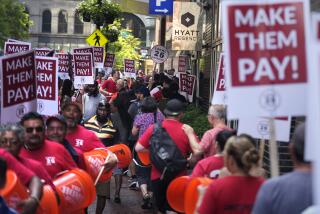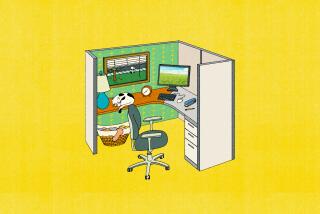EXECUTIVE TRAVEL : Fax Machines Instead of Postcards in the Drawer
- Share via
The concept of a “virtual office” is gaining strength in corporate America. Such an office exists wherever a worker and his or her computer happen to be, whether that’s company headquarters, home or a hotel room.
After attempting to retrofit their rooms with office paraphernalia in recent years, some hotels are now designing entirely new rooms with the working traveler in mind.
For the first time, for example, hotel chains are looking to office furniture giant Steelcase Inc. for help in equipping their rooms.
“Workers are forced to be more and more productive while they’re on the road,” said Gordon Lambourne, spokesman for Marriott Hotels in Washington, which recently announced a joint venture with Steelcase and AT&T; to create a new style of room that caters to the business traveler.
With laptop computers, sky-paging systems, cellular phones, e-mail and video conferencing capabilities, workers will no longer be able to say there is downtime while they’re traveling.
“Now you’ve got the home-office boss saying, ‘You’ve got all these technological tools while you’re on the road, so you’ve got to take care of your work back home.’ Your work can’t slip anymore because of travel,” Lambourne said.
And that raises the stakes in hotel room competition.
The current hotel room is based on a Victorian model of travel, said Richard Driscoll, director of business development for Michigan-based Steelcase. The big bureaus, which most business travelers never use, stem from the days when a traveler arrived at a destination and moved into a hotel room for a week or more. Other vestiges of that era include postcards in the drawers and big closets.
But according to ConsumerMetrics, a market research firm in Atlanta, about 70% of business travelers now use the guest room as an office and require special services to get their work done.
The hotel industry has tried various approaches to help the traveling worker. Some have set up central, on-site business centers. Others have set aside floors for business travelers, featuring shared conference rooms and other business equipment. A few have even put fax machines and computers in the rooms themselves. Most hotels charge more for rooms with business services included.
*
But such strategies have not been universally successful. Some business travelers have complained that they amount to little more than jury-rigging the room for business. For example, one frequent traveler griped that a hotel stuck a fax machine on top of a desk that was already too small to work on. Another complained that business centers were open only from 9 a.m. to 5 p.m., not during the odd hours he needed them to contact his home office in a different time zone.
Still others grumble about exorbitant fees for sending faxes, or the lack of a good work chair and adequate lighting. An executive who travels frequently said he heads for the local McDonald’s when he needs to get work done because the lighting is better than that in most hotel rooms. And simple things such as temperature control, or the lack of it, can make working in the room uncomfortable for some people.
Driscoll has some experience with this kind of inhospitable work climate on the road. For example, after being frequently frustrated trying to find or use hotel printers, he devised his own solution. “If I want to print something out, I’ll fax it to . . . the front desk,” he said. “But the point is, we shouldn’t have to figure out ways to get around these things.”
“Hotels are traditionally five to six years behind the [technology] curve,” Lambourne said. “Most people have better functionality in their own homes.”
Steelcase approached Marriott and several other chains about redesigning their rooms. The Marriott project is the furniture company’s most visible to date.
“We’re just following our customers, trying to make it so they can be productive wherever they are,” Driscoll said. That increasingly means enabling them to work in airports, hotel rooms and other non-traditional places.
In hotels, especially, “there is a convergence of people’s work lives and their leisure lives,” Driscoll said. “The lines are all being blurred.”
Traditional hotel room design was based on market research of guest preferences, as opposed to needs research, he said. “Hotels would put two choices in front of people and say, ‘Do you like the blue chair or the red chair?’ We ask them, ‘Do you sit in the room?’ ”
Research showed that business travelers want a large work space where they can set up quickly. They don’t want to have to hunt around for a place to plug in their computer equipment, and they especially don’t want to have to rewire the phone in order to use their modems, Lambourne said.
*
Because individual work habits vary, the goal was to let business travelers configure their work spaces to suit themselves, whether it was creating an L-shaped unit next to the wall or moving the work surface closer to the window.
“We heard that continually,” Driscoll said. “People said, ‘We want to have control,’ as opposed to everything being glued down.”
Marriott’s new room includes a Steelcase-designed work surface on wheels. The rolling table fits under a wall console with two power outlets and a modem jack, as well as movable task lighting. It comes with an ergonomically designed desk chair. Marriott expects to outfit 4,000 room in 15 business markets--including Los Angeles, Chicago, Dallas, New York, Washington, Hong Kong, London and Frankfurt--by the end of the year. Eventually, about 20% of Marriott’s rooms systemwide will be converted to the model.
And the company is already at work on a new generation of rooms, with a workstation that may look something like an armoire but will contain a personal computer, telecommunications equipment for in-room teleconferencing, printer, fax machine and flip charts.
Other hotel chains are also at work on rooms of the future. This week, Westin Hotels & Resorts unveiled its Room 2000, which includes such features as a touch screen on the bedside phone to control lighting, temperature, television, radio and drapes. The rooms, which won’t be available until the end of the decade, will also feature a system that allows guests to use the television to retrieve messages and look at faxes, desks with adjustable heights for writing or working on laptops, and beds that retract into the wall to become couches by day for meetings.
“Hotels have been missing the point entirely about what their business customers were saying,” Lambourne said. “They’re saying: ‘Spare me the free doughnuts in the morning. Just give me a way to get my work done.’ ”
More to Read
Sign up for The Wild
We’ll help you find the best places to hike, bike and run, as well as the perfect silent spots for meditation and yoga.
You may occasionally receive promotional content from the Los Angeles Times.






